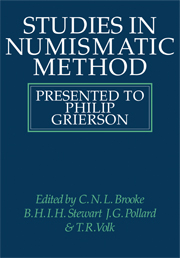Book contents
- Frontmatter
- Contents
- Acknowledgements
- Abbreviations
- Philip Grierson's contribution to numismatics
- A bibliography of the writings of Philip Grierson
- Introduction
- 1 Thoughts on the beginnings of coinage
- 2 The life of obverse dies in the Hellenistic period
- 3 Roman coinage of the Cyrenaica, first century bc to first century ad
- 4 Roman imperial coin types and the formation of public opinion
- 5 Coin hoards and Roman coinage of the third century AD
- 6 Belgian finds of late fourth-century Roman bronze
- 7 The re-use of obsolete coins: the case of Roman imperial bronzes revived in the late fifth century
- 8 Interpreting the alloy of the Merovingian silver coinagae
- 9 Carolingian gold coins from the Ilanz hoard
- 10 The novi denarii and forgery in the ninth century
- 11 On the rejection of good coin in Carolingian Europe
- 12 Ælfred the Great's abandonment of the concept of periodic recoinage
- 13 King or Queen? An eleventh-century pfennig of Duisburg
- 14 Personal names on Norman coins of the eleventh century: an hypothesis
- 15 The Gornoslav hoard, the Emperor Frederick I, and the Monastery of Bachkovo
- 16 Coinages of Barcelona (1209 to 1222): the documentary evidence
- 17 Finds of English medieval coins in Schleswig-Holstein
- 18 Privy-marking and the trial of the pyx
- 19 Judicial documents relating to coin forgery
- 20 Mint organisation in the Burgundian Netherlands in the fifteenth century
- 21 Coinage in Andrew Halyburton's Ledger
- 22 Imitation in later medieval coinage: the influence of Scottish types abroad
- 23 Barter in fifteenth-century Genoa
- Index
14 - Personal names on Norman coins of the eleventh century: an hypothesis
Published online by Cambridge University Press: 05 May 2010
- Frontmatter
- Contents
- Acknowledgements
- Abbreviations
- Philip Grierson's contribution to numismatics
- A bibliography of the writings of Philip Grierson
- Introduction
- 1 Thoughts on the beginnings of coinage
- 2 The life of obverse dies in the Hellenistic period
- 3 Roman coinage of the Cyrenaica, first century bc to first century ad
- 4 Roman imperial coin types and the formation of public opinion
- 5 Coin hoards and Roman coinage of the third century AD
- 6 Belgian finds of late fourth-century Roman bronze
- 7 The re-use of obsolete coins: the case of Roman imperial bronzes revived in the late fifth century
- 8 Interpreting the alloy of the Merovingian silver coinagae
- 9 Carolingian gold coins from the Ilanz hoard
- 10 The novi denarii and forgery in the ninth century
- 11 On the rejection of good coin in Carolingian Europe
- 12 Ælfred the Great's abandonment of the concept of periodic recoinage
- 13 King or Queen? An eleventh-century pfennig of Duisburg
- 14 Personal names on Norman coins of the eleventh century: an hypothesis
- 15 The Gornoslav hoard, the Emperor Frederick I, and the Monastery of Bachkovo
- 16 Coinages of Barcelona (1209 to 1222): the documentary evidence
- 17 Finds of English medieval coins in Schleswig-Holstein
- 18 Privy-marking and the trial of the pyx
- 19 Judicial documents relating to coin forgery
- 20 Mint organisation in the Burgundian Netherlands in the fifteenth century
- 21 Coinage in Andrew Halyburton's Ledger
- 22 Imitation in later medieval coinage: the influence of Scottish types abroad
- 23 Barter in fifteenth-century Genoa
- Index
Summary
Norman coins of the eleventh and twelfth centuries are so barbarous in appearance that numismatists and historians have paid little attention to them. A few years ago, however, J. Lafaurie, and then L. Musset, drew attention to the evidence they provide for Normandy's foreign relations. I propose to examine here the problems posed by the coinages which bear personal names; in particular, to consider whether these names are necessarily those of moneyers (monetarii), the usual explanation for names other than rulers on European medieval coins, or whether they might have some other significance.
The deniers of Normandy of the eleventh and twelfth centuries differ from other contemporary French coins in certain well-defined respects:
Obverse – the field is filled with non-representational devices based on a triangle or a cross. On the earliest group (A) the letters of the legend are clumsily engraved and are incoherently arranged; later (group B), these are replaced by geometric forms which give only the appearance of lettering (pseudo-legend); finally (group C), they disappear altogether.
Reverse – in group A the cross occupying the field is encircled by the blundered name of Rouen, then (group B) by a pseudo-legend, and finally (group C), by the legend NORMANNIA.
This development is accompanied by a degradation of the fabric. The flan ceases to be either regular or round, and its weight is reduced from 0.95 g. to 0.70 g., so that the later deniers have a characteristically degenerate appearance.
- Type
- Chapter
- Information
- Studies in Numismatic MethodPresented to Philip Grierson, pp. 171 - 178Publisher: Cambridge University PressPrint publication year: 1983



